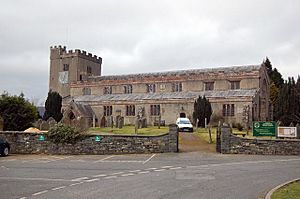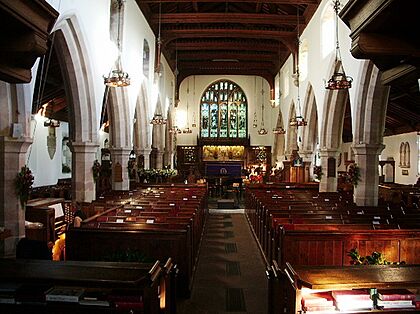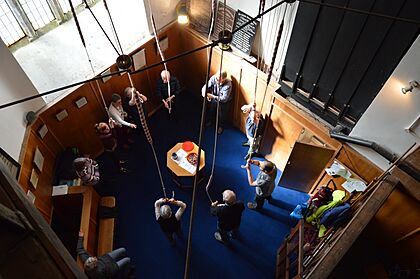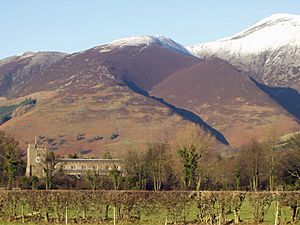St Kentigern's Church, Crosthwaite facts for kids
Quick facts for kids Crosthwaite Parish Church |
|
|---|---|
| St Kentigern's Church, Crosthwaite | |
 |
|
| OS grid reference | NY 25741 24285 |
| Location | Great Crosthwaite, Keswick, Cumbria |
| Country | England |
| Denomination | Church of England |
| Churchmanship | Evangelical |
| History | |
| Status | Active |
| Dedication | St Kentigern |
| Architecture | |
| Functional status | Parish Church |
| Heritage designation | Grade II* |
| Designated | 1951 |
| Completed | c. 1181 |
| Administration | |
| Deanery | Deanery of Derwent |
| Archdeaconry | Archdeacon of West Cumberland |
| Diocese | Diocese of Carlisle |
| Province | Province of York |
Crosthwaite Parish Church is a special old church located near Keswick in Cumbria, England. It's dedicated to a saint named St Kentigern. This church is part of the Church of England and has been a protected historical building since 1951. This means it's a very important building.
People believe there has been a church on this spot since the 6th century. The building you see today is mostly from the Middle Ages. Some parts were changed inside during the Victorian era. A famous vicar of this church was Hardwicke Rawnsley. He helped start the National Trust, which protects important places.
Contents
History of Crosthwaite Church
Early Churches and First Stone Building
The very first church at Crosthwaite was likely built in 553 AD. This was under the guidance of St Kentigern. He shared his teachings in the area before moving to Wales. We don't have any records of this first building. It was probably made of wood, just like the Saxon church that came after it.
In 1181, a writer named Jocelyn of Furness mentioned a new stone church. This church was built for Alice de Romilly, who was a local lady. This new stone church had a main area called a nave. It also had a north aisle and a chancel with an arch. It did not have a south aisle or a tower yet. The foundations of this old building are still there today.
Monks and Medieval Changes
In 1189, King Richard I gave the church's rectory to the Cistercian monks. These monks were from Fountains Abbey in Yorkshire. For the next 300 years, monks from the abbey worked in the parish. They lived at Monks Hall, which is now the site of Keswick hospital.
During the 14th century, around 1340, a small chapel was added. This chapel was built on the north side of the chancel. Later, a south aisle was also added to the church. In the early 16th century, big changes happened. The chancel arch was taken away. A clerestory, which is a row of windows high up, was added. Also, existing side chapels were rebuilt. The last major change in the medieval period was building the current tower. We don't know the exact date it was finished.
Victorian Restorations and Modern Additions
The church was not changed much in the 17th and 18th centuries. It was also not very well looked after. In the 19th century, a lot of work was done inside the church. Some of these changes were not very good, according to historians.
A famous architect named George Gilbert Scott helped restore the church in 1844. This work was paid for by a local person. It was part of a memorial for the poet Robert Southey, who is buried in the churchyard. Besides Scott's changes inside, the church also got a new roof and new seating. The altar designed by Scott was moved to St John's in the Vale church in 1893.
In 1909, the western end of the south aisle became a baptistry. This was to celebrate Hardwicke Rawnsley's 25 years as vicar. The font, which is used for baptisms, was moved to this new area. This font was given to the church around 1400. The water jug for the font was made at the Keswick School of Industrial Art. Rawnsley's wife, Edith, helped start this art school.
Features of Crosthwaite Parish Church
The Organ and War Memorial
The church has a very large organ. The current organ was built in 1920. It was made by rebuilding and making an older organ, from 1837, much bigger. This organ is dedicated to the men from Crosthwaite who died in the First World War. Their names are written on a special plaque in the north aisle of the church.
The Church Bells and Ringing Rules
Crosthwaite Church has a ring of eight bells. The largest bell, called the tenor bell, weighs about 787 kilograms. In 1765, the church had four bells. This number increased to six in 1767. Finally, in 1882, the church got its current eight bells.
It's unusual for churches in Cumbria, but these bells are rung from the ground floor. This means they have a special system of ropes to guide them. People can easily watch the bell ringing through glass windows. The first full "peal" on these bells happened on December 17, 1895. A peal is a long sequence of bell changes.
There is a remarkable set of rules for the bell ringers. These rules are from 1826. They are displayed in a large frame in the ringing room. A teacher from St Bees School wrote them.
Consecration Crosses and Other Art
The church has special Tudor consecration crosses. These crosses are both inside and outside the building. It's unique because it once had a complete set of twelve crosses on the outside. Nine crosses still remain inside. The other three were likely accidentally destroyed during restoration work in the 19th century. These crosses show that the church was officially set aside for worship in a specific way.
In the 1960s, a writer named John Betjeman pointed out many interesting features. He mentioned the beautifully carved 14th-century font. He also noted several 15th-century statues. The reredos, which is a screen behind the altar, was made by the Keswick School of Industrial Art. The altar itself has a banner with a Greek motto. This motto means "in this sign you will conquer." This phrase was used by Constantine the Great and the Knights Templar.
The reredos includes three special panels. These panels were made using a technique called repoussé. Edith Rawnsley and John Birkett created them. They also made the hanging lights, the mosaics, and the pulpit.
Monuments and Churchyard
The monument for Robert Southey was made in 1846 by John Graham Lough. Southey is shown in marble, with one hand on his heart and the other on a book. The famous poet William Wordsworth wrote the words on the monument. They say: "Ye Vales and Hills, whose beauty hither drew/The poet's steps, and fixed him here, on you/His eyes have closed."
The churchyard has some "outstandingly good" gravestones made of slate. It also has many "Celtic cross headstones."
Vicars of Crosthwaite Church
The first vicar of Crosthwaite we know about was Jeffrey Wethamstede in 1294. Perhaps the most well-known vicar was Hardwicke Rawnsley. He was a co-founder of the National Trust. Rawnsley became the vicar of Crosthwaite in 1883. After 34 years, he retired to Grasmere. He is buried in the churchyard of Crosthwaite, near Robert Southey's grave. As of 2020, the vicar is the Rev Andy Murphie. He followed the Rev Stuart Penny.
See also
- Grade II* listed buildings in Cumberland
- Listed buildings in Keswick, Cumbria
- List of churches in Allerdale




